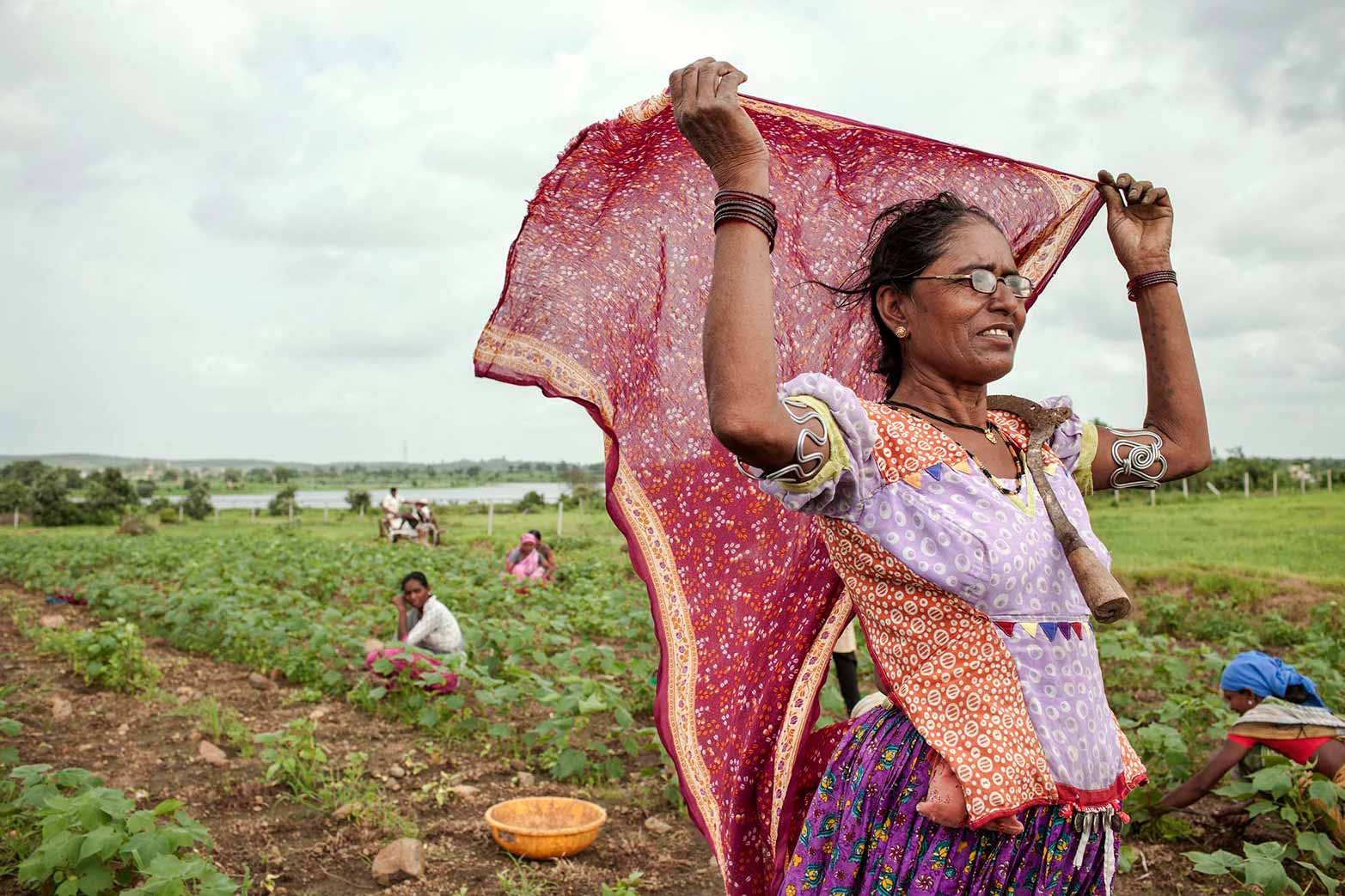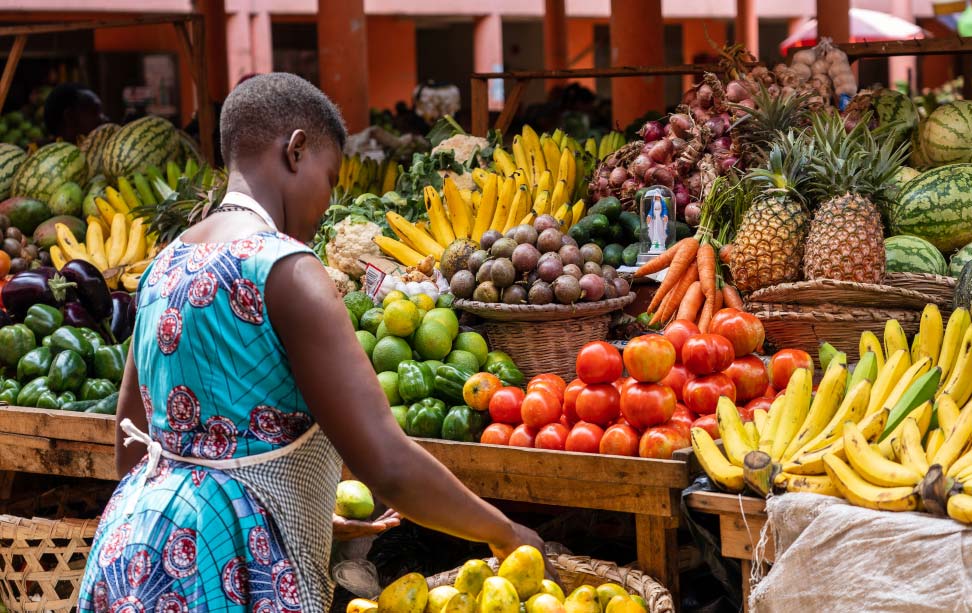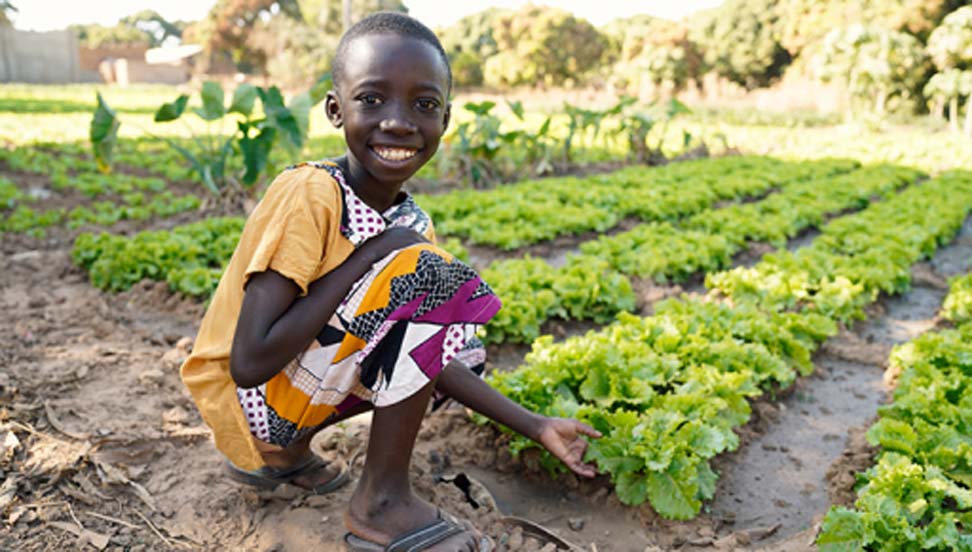
IFPRI Publications: Journal Articles
Explore Our Latest Journal Articles
By Title By Author By Country/Region By Keyword
Journal Article
Armed conflict, community-based cash transfers, and social cohesion: Evidence from a randomized intervention in Ethiopia
Journal Article
Can a light-touch graduation model enhance livelihood outcomes? Evidence from Ethiopia
Journal Article
When prices spike: Identifying excessive volatility in fertilizer markets
Journal Article
Pork safety across Vietnam’s traditional markets: microbial contamination and vendor knowledge, attitudes, and practices
…more
Hung Nguyen-VietJournal Article
The effect of teacher training and community literacy programming on teacher and student outcomes
Journal Article
Agricultural technology adoption and deforestation: Evidence from a randomized control trial
Journal Article
Understanding social safety nets and intra-household food allocation: Experimental evidence from Bangladesh
Journal Article
The effect of using indigenous and scientific forecasts on arable farmers’ crop yields: Evidence from Rwenzori region, western Uganda
Journal Article
Transfers, information and management advice: Direct effects and complementarities in Malawi
Journal Article
Increasing women’s empowerment: Evaluating two interventions in Uganda
Journal Article
How much do our neighbors really know? The limits of community-based targeting
Journal Article
Constraints and promising interventions to strengthen fish seed systems in Sub-Saharan Africa: Evidence from Ghana
Journal Article
COVID-19 and rural livelihoods: Lessons from a longer-term assessment and the path to recovery
Journal Article
Estimating multidimensional development resilience
Journal Article
Higher altitude stunts children’s physical growth: A systematic review and meta-analysis
Journal Article
How can anticipatory action programming support women? Application of the reach-benefit-empower-transform framework in Nepal and Nigeria
Journal Article
Exposure and disease burden of fumonisins and aflatoxins from sorghum consumption in Ethiopia
Journal Article
Vouchers to increase fruit affordability in Nigeria and Vietnam
Journal Article
Gendered networks and demand for an agricultural technology in India
Journal Article
Imperfect competition and asymmetric welfare effects of global price and productivity shocks: a CGE model analysis for Senegal
Journal Article
Understanding spatial heterogeneity of hidden hunger in Senegal
Journal Article
Step by step to higher yields? Adoption and impacts of a sequenced training approach for climate-smart coffee production in Uganda
Journal Article
Whole maize flour could enhance food and nutrition security in Malawi
Journal Article
How social norms influence processes of change related to an economic intervention in Bangladesh
Journal Article
Does small-scale irrigation affect women’s time allocation? Insights from Ethiopia
Journal Article
Integrating carbon sequestration and yield optimization in Indian cropping systems
Journal Article
The characteristics of community seed schemes for grains and legumes: Insights from northern Nigeria
Journal Article
Buyer-side gender discrimination in bargaining: Evidence from seed sales in Uganda
Journal Article
From data to decision: How the National Information Platform for Nutrition (NiPN) bridges the research-policy gap in Ethiopia’s nutrition sector
Journal Article
Household food production and dietary diversity in a remote, former socialist society: Panel data evidence from Tajikistan
Journal Article
Rice milling and parboiling trade-offs for economic and nutritional gains with special attention to sub-Saharan Africa: A comprehensive review
Journal Article
A measure of industrial clustering: Considering relatedness and scale
Journal Article
Optimal anthropometric discharge criteria from treatment of wasting: Meta-analysis of individual patient data from 34 studies
…more
Barthorp, Harriet; Becquet, Renaud; Belchior-Bellino, Valérie; Beri, Alemayehu; Berthé, Fatou; Bhandari, Nita; Bose, Anuradha; Burza, Sakib; Casademont, Cristian; Cazes, Cécile; Chaturvedi, Anuraag; Collins, Steve; Coulibaly, Issa; Cuneo, C Nicholas; Dansereau, Emily; Daures, Maguy; Diala, Udochukwu; Djibo, Ali; Escruela, Montserrat; Faal, Abdoulie; Griswold, Stacy; Guesdon, Benjamin; Guindo, Ousmane; Hien, Jérémie; Hossain, Md Iqbal; Hug, Julia; Iyengar, Sharad; Jasper, Paul; John, Collins; Kangas, Suvi T.; Kornetsky, Kenneth; Lambebo, Abera; Legese, Liya; Lelijveld, Natasha; Mahajan, Raman; Manary, Mark; Mohan, Sanjana; Myatt, Mark; Nabwera, Helen; Nackers, Fabienne; Nahar, Baitun; Olufemi, Adegoke; Patwari, Ashok; Phelan, Kevin; Rocaspana, Mercè; Rogers, Beatrice; Sadler, Kate; Salpeteur, Cecile; Sonko, Bakary; Soofi, Sajid; Taneja, Sunita; Tripathy, Prasanta; Wegner, DonnaJournal Article
Polycentric governance of commons through multi-stakeholder platforms: Insights from two case studies in India
Journal Article
Women as breadwinners: A multifaceted relocation program and women’s labour market outcomes
Journal Article
Agricultural innovation frames, policies, and instruments: Evolution, lessons, and future research
Journal Article
Vulnerability of Nigerian maize traders to a confluence of climate, violence, disease and cost shocks
Journal Article
Unlock genotype-environment-management interaction via field phenotypic insights for multi-scale prediction of winter rapeseed flowering in the Yangtze River Basin
Journal Article
Impact of conflict shocks on land rental market dynamics: Panel evidence from Nigeria
Journal Article
Food acquisition, preparation, and consumption practices in South Asia: A scoping review of assessment tools
Journal Article
Food price stabilization: Theory and lessons from experience
Journal Article
Aflatoxin contamination of maize flour in Kenya: Results from multi-city, multi-round surveillance
Journal Article
The role of genotyping in measuring improved variety adoption and impact: Advances, challenges, and policy directions
…more
Afari-Sefa, Victor; Pingali, PrabhuJournal Article
Multivariate stability analysis to select elite rice (Oryza sativa L.) genotypes for grain yield, zinc and iron
Journal Article
Exploring rancidity in pearl millet flour: A lipidomic and biochemical approach
…more
Bhatnagar-Mathur, PoojaJournal Article
Methods for estimating beneficiary populations targeted by health and nutrition interventions for women, pregnant women, infants, and young children
Journal Article
Aggregation models in agricultural value chains of staple crops and their potential application for biofortification: A scoping review
Journal Article
Farmers agronomic management responses to extreme drought and rice yields in Bihar, India
…more
Malik, Ram; McDonald, AndrewJournal Article
The linkages between water supply, sanitation and hygiene and small-scale irrigation: Insights from rural Ethiopia
Journal Article
Effect of azithromycin on post-discharge growth in Kenyan children
…more
Bogonko, George; Nduati, Ruth; Richardson, Barbra A; John-Stewart, Grace; Walson, Judd L; Singa, Benson O; Pavlinac, Patricia B; McGrath, Christine JJournal Article
Resilience in technical efficiency and enabling factors: Insights from panel farm enterprise surveys in Kazakhstan and Uzbekistan
Journal Article
Prevalence of large‐for‐gestational age and macrosomia among livebirths in 23 low‐ and middle‐income countries between 2000 and 2021: An individual participant data analysis
…more
Roberfroid, Dominique; Huybregts, Lieven; Labrique, Alain B.; Rashid, Mabhubur; Shaikh, Saijuddin; Haque, Rezwanul; Baqui, Abdullah H.; Saha, Samir K.; Khanam, Rasheda; Rahman, Sayedur; Silveira, Md Mariângela F.; Buffarini, Romina; Shapiro, Roger L.; Zash, Rebecca; Zhu, Zhonghai; Zeng, Lingxia; Qiu, Xiu; He, Jianrong; Gebreyesus, Seifu H.; Tesfamariam, Kokeb; Chan, Grace; Bekele, Delayehu; Adu‐Afarwuah, Seth; Dewey, Kathryn G.; Gyaase, Stephaney; Wylie, Blair J.; Taneja, Sunita; Chowdhury, Ranadip; Babu, Giridhara R.; Deepa, R.; Rishard, Mohamed; Lazzerini, Marzia; Rodriguez‐Sibaja, Maria J.; Acevedo‐Gallegos, Sandra; Ashorn, Per; Maleta, Kenneth; Mullany, Luke C.; Jehan, Fyezah; Ilyas, Muhammad; Rogerson, Stephen J.; Unger, Holger W.; Ghosh, Rakesh; Musange, Sabine; Mongkolchati, Aroonsri; Keentupthai, Paniya; Fawzi, Wafaie; Wang, Dongqing; Schmiegelow, Christentze; Minja, Daniel; Hjort, Line; Lusingu, John P. A.; Smith, Emily R.; Masanja, Honorati; Kabole, Fathma Mohamed; Slim, Salim Nassir; Kakuru, Abel; Kajubi, Richard; Walker, Dilys; Waiswa, Peter; Ramokolo, Vundli; Zembe‐Mkabile, Wanga; Semrau, Katherine; Hamer, Davidson H.; Chico, R. Matthew; Chaponda, Enesia Banda; Manasyan, Albert; Pry, Jake M.; Musokotwane, Kebby; Banda, Bowen; Prendergast, Andrew; Chasekwa, Bernard; Katz, Joanne; Lee, Anne C. C.; Black, Robert E.Journal Article
Neonatal mortality risk of vulnerable newborns by fine stratum of gestational age and birthweight for 230 679 live births in nine low- and middle-income countries, 2000-2017
…more
Baqui, Abdullah H.; Saha, Samir K.; Ahmed, Salahuddin; Roy, Arunangshu Dutta; Silveira, Mariângela F.; Buffarini, Romina; Shapiro, Roger; Zash, Rebecca; Kolsteren, Patrick; Lachat, Carl; Huybregts, Lieven; Roberfroid, Dominique; Zhu, Zhonghai; Zeng, Lingxia; Gebreyesus, Seifu H.; Tesfamariam, Kokeb; Adu-Afarwuah, Seth; Dewey, Kathryn G.; Gyaase, Stephaney; Poku-Asante, Kwaku; Boamah Kaali, Ellen; Jack, Darby; Ravilla, Thulasiraj; Tielsch, James; Taneja, Sunita; Chowdhury, Ranadip; Ashorn, Per; Maleta, Kenneth; Ashorn, Ulla; Mangani, Charles; Mullany, Luke C.; Khatry, Subarna K.; Ramokolo, Vundli; Zembe-Mkabile, Wanga; Fawzi, Wafaie W.; Wang, Dongqing; Schmiegelow, Christentze; Minja, Daniel; Msemo, Omari Abdul; Lusingu, John P. A.; Smith, Emily R.; Masanja, Honorati; Mongkolchati, Aroonsri; Keentupthai, Paniya; Kakuru, Abel; Kajubi, Richard; Semrau, Katherine; Hamer, Davidson H.; Manasyan, Albert; Pry, Jake M.; Chasekwa, Bernard; Humphrey, Jean; Black, Robert E.Journal Article
Role of international price and domestic inflation in triggering export restrictions on food commodities
Journal Article
Information delivery in times of crisis: Evaluating digitally-supported agricultural extension in Myanmar
Journal Article
Impact of production-and consumption-oriented interventions on crop varietal adoption: Cluster-randomized controlled trial evidence from northern Nigeria
Journal Article
Prospects of crop insurance for sustenance of farmers’ livelihood during GM cotton crop failure in Indian Punjab
Journal Article
Cities and agricultural development
Journal Article
Gender-just mitigation in the agrifood systems sector: Potential and pitfalls
Journal Article
The unintended consequences of social transfer programs: Effects on conflict, governance, and social cohesion
Journal Article
Simulated impact of vitamin A-fortified sugar on dietary adequacy and association of usual sugar intake with plasma and breast milk retinol among lactating Zambian women
…more
Palmer, Amanda C.Journal Article
Food prices are likely to remain high and volatile
Journal Article
Miracle seeds: Biased expectations, complementary input use, and the dynamics of smallholder technology adoption
Journal Article
From promises to action: Analyzing global commitments to tackle hunger and food insecurity
Journal Article
Zinc distribution in structural components of high kernel‑zinc maize and its retention after milling
Journal Article
Confidence and information usage: Evidence from soil testing in India
Journal Article
Affordability and nutritional challenges for the future of EAT diets: An economic modelling analysis
Journal Article
Between code and conscience: Early-career researcher reflections on agroeconomic modelling and international research collaboration
Journal Article
Effect of terminal heat stress on stay-green and senescence process could explain genetic variation in grain yield and nutritional profile in wheat (Triticum aestivum L.)
Journal Article
Is subjective wellbeing too subjective? The (large) impact of randomized placement of happiness and worry questions in a national survey of crisis-affected Myanmar
Journal Article
Exploring the barriers and facilitators of nutrition and dietary intake among school-aged children in the urban low-income setting of Addis Ababa
Journal Article
Beyond the bids: Lessons from farmers’ reflections on Vickrey auctions of sweetpotato vines in Rwanda
Journal Article
Policy and regulation in seed sector development for vegetatively propagated crops: Insights from Kenya, Nigeria, and Vietnam
Journal Article
The role of access to expressways on industrial clustering development in China
Journal Article
Bundling measures for food systems transformation: A global, multimodel assessment
…more
de Lange, Thijs; Doelman, Jonathan; Dunston, Shahnila; Frank, Stefan; Fujimori, Shinichiro; Hasegawa, Tomoko; Havlik, Petr; Hristov, Jordan; Jägermeyr, Jonas; Kozicka, Marta; Kuiper, Marijke; Kyle, Page; Lotze-Campen, Hermann; Luchtenbelt, Hermen; Mishra, Abhijeet; Müller, Christoph; Nelson, Gerald C.; Palazzo, Amanda; Pérez Domínguez, Ignacio; Popp, Alexander; Sands, Ronald; Springmann, Marco; Stehfest, Elke; Sulser, Timothy B.; Takahashi, Kiyoshi; Tassinari, Gianmaria; Thom, Ferike; Thornton, Philip K.; Tsuchiya, Kazuaki; van Zeist, Willem-Jan; van Meijl, Hans; van der Mensbrugghe, Dominique; Van Vuuren, Detlef; van Zanten, Hannah H. E.; Weindl, Isabelle; Wiebe, Keith D.; Zhao, Xin; Herrero, MarioJournal Article
Looks matter? Field performance and farmers’ preferences for drought-tolerant maize in Kenya
Journal Article
The EAT–Lancet Commission on healthy, sustainable, and just food systems
…more
Agustina, Rina; Bajaj, Sumati; Bunge, Anne Charlotte; Carducci, Bianca; Conti, Costanza; Covic, Namukolo; Fanzo, Jessica; Forouhi, Nita G.; Gibson, Matthew F.; Gu, Xiao; Kebreab, Ermias; Kremen, Claire; Laila, Amar; Laxminarayan, Ramanan; Marteau, Theresa M.; Monteiro, Carlos A.; Norberg, Anna; Njuki, Jemimah; Oliveira, Thais Diniz; Pan, Wen-Harn; Rivera, Juan A.; Robinson, James P. W.; Sundiang, Marina; te Wierik, Sofie; van Vuuren, Detlef P.; Vermeulen, Sonja; Webb, Patrick; Alqodmani, Lujain; Ambikapathi, Ramya; Barnhill, Anne; Baudish, Isabel; Beier, Felicitas; Beillouin, Damien; Beusen, Arthur H. W.; Breier, Jannes; Chemarin, Charlotte; Chepeliev, Maksym; Clapp, Jennifer; de Vries, Wim; Pérez-Domínguez, Ignacio; Estrada-Carmona, Natalia; Gerten, Dieter; Golden, Christopher D.; Jones, Sarah K.; Jørgensen, Peter Søgaard; Kozicka, Marta; Lotze-Campen, Hermann; Maggi, Federico; Marzi, Emma; Mishra, Abhijeet; Orduna-Cabrera, Fernando; Popp, Alexander; Schulte-Uebbing, Lena; Stehfest, Elke; Tang, Fiona H. M.; Tsuchiya, Kazuaki; Van Zanten, Hannah H. E.; van Zeist, Willem-Jan; Zhao, Xin; DeClerck, FabriceJournal Article
Economy-wide implications of increasing school enrolment in Sub-Saharan Africa
Journal Article
Rural income diversification in Ethiopia: Drivers and welfare impact
Journal Article
Analysis of antibiotic use, biosecurity and mortality in semi-intensive broiler farms in Kenya
Journal Article
Biofortification as a food-based strategy to improve nutrition in high-income countries: A scoping review
Journal Article
Can the global drone revolution make agriculture more sustainable? Rapid growth in drone use is upending expectations but also inducing trade-offs
Journal Article
Phytosanitary challenges and solutions for roots and tubers in the tropics
…more
Atieno, Elly; Garrett, Karen A.Journal Article
Developing green nutritious super rice for a healthy anthropocene
…more
Wing, Rod; Xiong, Lizhong; Yu, Sibin; Chen, Hao; Li, Yibo; Ouyang, YidanJournal Article
Assessing institutional capacities to demand and use nutrition data for decision-making in Nigeria’s health sector: A mixed-methods study
Journal Article
Preventing relapse from wasting: the role of sociodemographic, child feeding, and health care determinants and of wasting prevention interventions in Burkina Faso and Mali
Journal Article
Varietal turnover in potato and its effect on yield: Evidence from household surveys in India
Journal Article
Traders and agri-food value chain resilience: The case of maize in Myanmar
Journal Article
Financing food systems in times of global disorder
Journal Article
New insights into the measurement of household well-being for vulnerable economies: Evidence from Pakistan’s labor and diet data
Journal Article
How good are livestock statistics in Africa? Can nudging and direct counting improve the quality of livestock asset data?
Journal Article
Private sector promotion of agricultural technologies: Experimental evidence from Nigeria
Journal Article
Herder-related violence, labor allocation, and the gendered response of agricultural households
Journal Article
The complex economics of a complete ban on child labor in the cobalt supply chain: The case of the DR Congo
Journal Article
Social identity and crisis resilience in agriculture: Caste, gender, and migration in Nepal
Journal Article
A critical approach to co-producing knowledge for development
Journal Article
Foreword to a scoping review of Interventions on fruit and vegetable intake in low-, middle-, and high-income countries: A global perspective
Journal Article
What drives fast food consumption in Asian low-and middle-income countries? A narrative review of patterns and influencing factors
Journal Article
Heavy metal contamination in urban agriculture: Evidence from Nairobi
Journal Article



